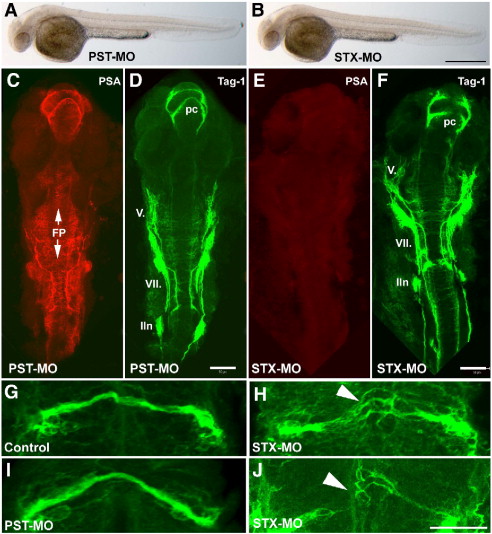Fig. 4 Knockdown of Stx produces abnormal axonal growth and guidance in developing zebrafish. (A, B) Embryos at 32 hpf injected with PST- (A) or STX-specific (B) morpholinos do not show any evident phenotype defects or increases in the rate of mortality. (C–F) Embryos at 32 hpf after morpholino knockdown of polysialyltransferases Stx and Pst immunolabeled for PSA (mab 735, red) and the axonal marker Tag-1 (in green). (C, D) Knockdown of Pst neither alters PSA immunoreactivity nor the growth pattern of axons. PSA is expressed by cells in the CNS, the floorplate, on axons and nuclei of cranial nerves V. and VII., and on axons of the posterior commissure (pc). (E,F) Knockdown of Stx leads to a complete loss of PSA-immunoreactivity (E), whereas the overall development is not severely disturbed (F). (G–J) Growth pattern of pc in control (G) and in PST-MO embryos (I), axons of the pc grow in a fasciculated bundle. After Stx knockdown, the PC splits into several bundles (H, arrowhead), or axons do not cross the midline (J, arrowhead). FP, floorplate; lln, lateral line nerve; pc, posterior commissure; V., trigeminal nuclei and axons; VII., facial nuclei and axons. Images in C–J are projections of confocal images, rostral to the top. Scale bars: 500 μm (A–B), 50 μm (C–F), 20 μm (G–J).
Reprinted from Developmental Biology, 306(2), Marx, M., Rivera-Milla, E., Stummeyer, K., Gerardy-Schahn, R., and Bastmeyer, M., Divergent evolution of the vertebrate polysialyltransferase Stx and Pst genes revealed by fish-to-mammal comparison, 560-571, Copyright (2007) with permission from Elsevier. Full text @ Dev. Biol.

